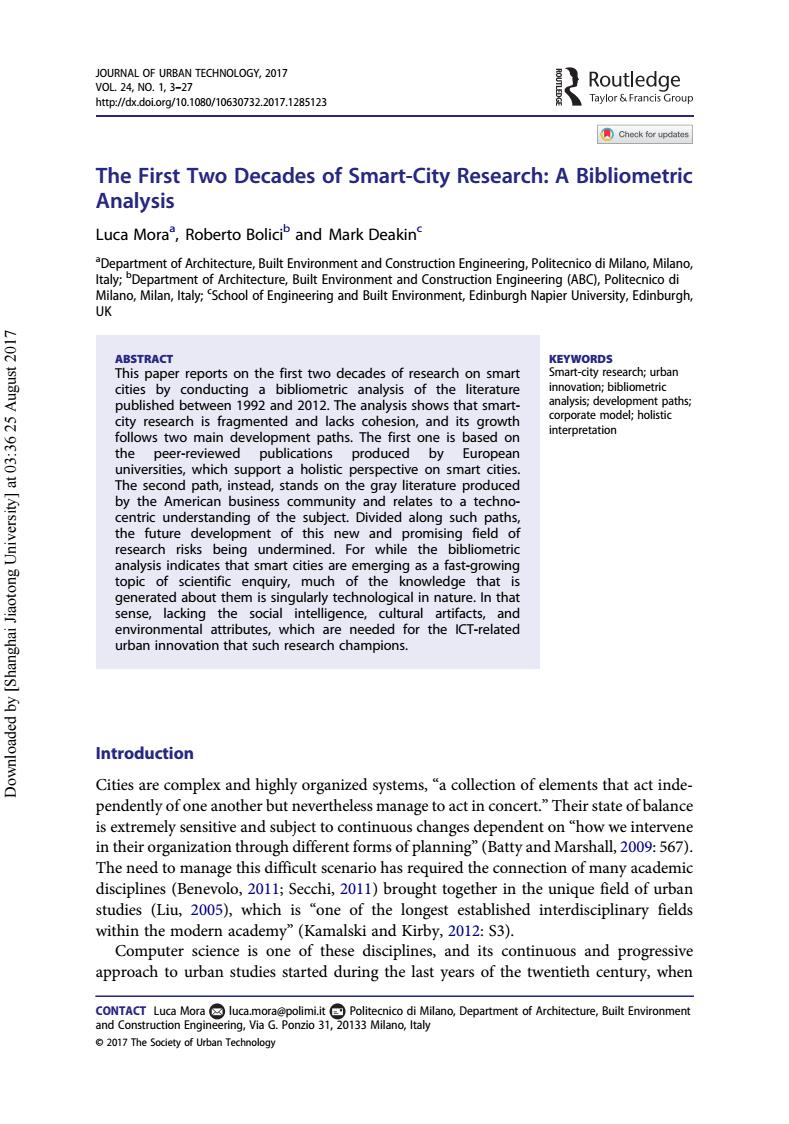正在加载图片...

JOURNAL OF URBAN TECHNOLOGY,2017 V0L24,N0.1,3-27 Routledge http:/k.doi.org/10.1080/10630732.2017.1285123 Taylor Francis Group Check for updates The First Two Decades of Smart-City Research:A Bibliometric Analysis Luca Mora,Roberto Bolici and Mark Deakin aDepartment of Architecture,Built Environment and Construction Engineering,Politecnico di Milano,Milano, Italy;PDepartment of Architecture,Built Environment and Construction Engineering (ABC),Politecnico di Milano,Milan,Italy:School of Engineering and Built Environment,Edinburgh Napier University,Edinburgh, UK ABSTRACT KEYWORDS This paper reports on the first two decades of research on smart Smart-city research;urban cities by conducting a bibliometric analysis of the literature innovation;bibliometric published between 1992 and 2012.The analysis shows that smart- analysis;development paths; city research is fragmented and lacks cohesion,and its growth corporate model;holistic follows two main development paths.The first one is based on interpretation the peer-reviewed publications produced by European universities,which support a holistic perspective on smart cities. The second path,instead,stands on the gray literature produced by the American business community and relates to a techno- centric understanding of the subject.Divided along such paths, the future development of this new and promising field of research risks being undermined.For while the bibliometric analysis indicates that smart cities are emerging as a fast-growing topic of scientific enquiry,much of the knowledge that is SuojoeIf leyueyS] generated about them is singularly technological in nature.In that sense,lacking the social intelligence,cultural artifacts,and environmental attributes,which are needed for the ICT-related urban innovation that such research champions. 入Ko Introduction Cities are complex and highly organized systems,"a collection of elements that act inde- pendently of one another but nevertheless manage to act in concert."Their state of balance is extremely sensitive and subject to continuous changes dependent on"how we intervene in their organization through different forms of planning"(Batty and Marshall,2009:567). The need to manage this difficult scenario has required the connection of many academic disciplines (Benevolo,2011;Secchi,2011)brought together in the unique field of urban studies (Liu,2005),which is "one of the longest established interdisciplinary fields within the modern academy"(Kamalski and Kirby,2012:S3). Computer science is one of these disciplines,and its continuous and progressive approach to urban studies started during the last years of the twentieth century,when CONTACT Luca Mora luca.mora@polimi.it Politecnico di Milano,Department of Architecture,Built Environment and Construction Engineering,Via G.Ponzio 31,20133 Milano,Italy 2017 The Society of Urban TechnologyThe First Two Decades of Smart-City Research: A Bibliometric Analysis Luca Moraa , Roberto Bolicib and Mark Deakinc a Department of Architecture, Built Environment and Construction Engineering, Politecnico di Milano, Milano, Italy; b Department of Architecture, Built Environment and Construction Engineering (ABC), Politecnico di Milano, Milan, Italy; c School of Engineering and Built Environment, Edinburgh Napier University, Edinburgh, UK ABSTRACT This paper reports on the first two decades of research on smart cities by conducting a bibliometric analysis of the literature published between 1992 and 2012. The analysis shows that smartcity research is fragmented and lacks cohesion, and its growth follows two main development paths. The first one is based on the peer-reviewed publications produced by European universities, which support a holistic perspective on smart cities. The second path, instead, stands on the gray literature produced by the American business community and relates to a technocentric understanding of the subject. Divided along such paths, the future development of this new and promising field of research risks being undermined. For while the bibliometric analysis indicates that smart cities are emerging as a fast-growing topic of scientific enquiry, much of the knowledge that is generated about them is singularly technological in nature. In that sense, lacking the social intelligence, cultural artifacts, and environmental attributes, which are needed for the ICT-related urban innovation that such research champions. KEYWORDS Smart-city research; urban innovation; bibliometric analysis; development paths; corporate model; holistic interpretation Introduction Cities are complex and highly organized systems, “a collection of elements that act independently of one another but nevertheless manage to act in concert.” Their state of balance is extremely sensitive and subject to continuous changes dependent on “how we intervene in their organization through different forms of planning” (Batty and Marshall, 2009: 567). The need to manage this difficult scenario has required the connection of many academic disciplines (Benevolo, 2011; Secchi, 2011) brought together in the unique field of urban studies (Liu, 2005), which is “one of the longest established interdisciplinary fields within the modern academy” (Kamalski and Kirby, 2012: S3). Computer science is one of these disciplines, and its continuous and progressive approach to urban studies started during the last years of the twentieth century, when © 2017 The Society of Urban Technology CONTACT Luca Mora luca.mora@polimi.it Politecnico di Milano, Department of Architecture, Built Environment and Construction Engineering, Via G. Ponzio 31, 20133 Milano, Italy JOURNAL OF URBAN TECHNOLOGY, 2017 VOL. 24, NO. 1, 3–27 http://dx.doi.org/10.1080/10630732.2017.1285123 Downloaded by [Shanghai Jiaotong University] at 03:36 25 August 2017